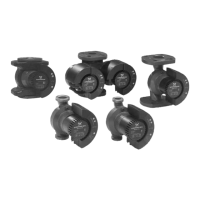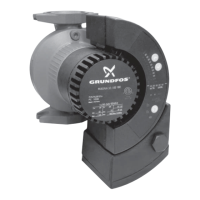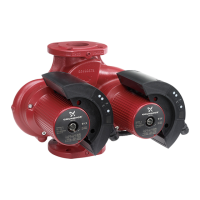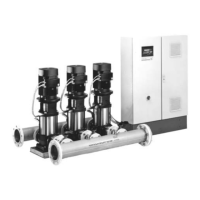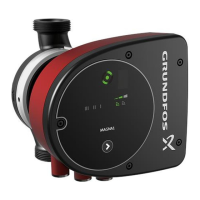13
7.2 Selection of control mode
7.2.1 Setpoint setting
If AUTO
ADAPT is selected, the setpoint cannot be set.
The setpoint can be set by pressing or when
the pump is in control mode:
• proportional pressure
• constant pressure
• constant-curve duty.
Set the setpoint so that it matches the system.
A too high setting may result in noise in the system
whereas a too low setting may result in insufficient
heating or cooling in the system.
System type Description
Select this
control mode
Typical heating
systems
Grundfos recommends to let the pump remain in AUTO
ADAPT mode.
This ensures optimum performance at the lowest possible energy
consumption.
AUTO
ADAPT
Relatively great
head losses in
the distribution
pipes and air-
conditioning
systems
1. Two-pipe
heating
systems with
thermostatic
valves and:
• with a dimensioned pump head higher than
4metres,
Proportional
pressure
• very long distribution pipes,
• strongly throttled pipe balancing valves,
• differential pressure regulators,
• great head losses in those parts of the system
through which the total quantity of water flows
(e.g. boiler, heat exchanger and distribution pipe up
to the first branching).
2. Primary circuit pumps in systems with great head losses in the primary
circuit.
3. Air-
conditioning
systems with
• heat exchangers (fan coils),
• cooling ceilings,
• cooling surfaces.
Relatively small
head losses in
the distribution
pipes
1. Two-pipe
heating
systems with
thermostatic
valves and:
• with a dimensioned pump head lower than
2metres,
Constant
pressure
• dimensioned for natural circulation,
• with small head losses in those parts of the system
through which the total quantity of water flows
(e.g. boiler, heat exchanger and distribution pipe up
to the first branching) or
• modified to a high differential temperature between
flow pipe and return pipe (e.g. district heating).
2. Underfloor heating systems with thermostatic valves.
3. One-pipe heating systems with thermostatic valves or pipe balancing
valves.
4. Primary circuit pumps in systems with small head losses in the primary
circuit.

